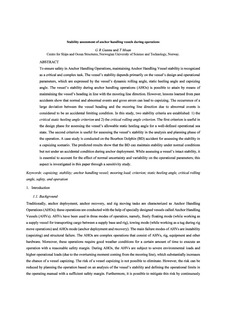| dc.contributor.author | Gunnu, Giriraja Sekhar | |
| dc.contributor.author | Moan, Torgeir | |
| dc.date.accessioned | 2019-03-04T13:29:14Z | |
| dc.date.available | 2019-03-04T13:29:14Z | |
| dc.date.created | 2017-09-13T15:19:00Z | |
| dc.date.issued | 2018 | |
| dc.identifier.citation | Journal of Marine Science and Technology. 2018, 23 (2), 201-227. | nb_NO |
| dc.identifier.issn | 0948-4280 | |
| dc.identifier.uri | http://hdl.handle.net/11250/2588526 | |
| dc.description.abstract | To ensure safety in anchor handling operations, maintaining anchor handling vessel stability is recognized as a critical and complex task. The vessel’s stability depends primarily on the vessel’s design and operational parameters, which are expressed by the vessel’s dynamic rolling angle, static heeling angle, and capsizing angle. The vessel’s stability during anchor handling operations (AHOs) is possible to attain by means of maintaining the vessel’s heading in line with the mooring line direction. However, lessons learned from past accidents show that normal and abnormal events and gross errors can lead to capsizing. The occurrence of a large deviation between the vessel heading and the mooring line direction due to abnormal events is considered to be an accidental limiting condition. In this study, two stability criteria are established: (1) the critical static heeling angle criterion and (2) the critical rolling angle criterion. The first criterion is useful in the design phase for assessing the vessel’s allowable static heeling angle for a well-defined operational sea state. The second criterion is useful for assessing the vessel’s stability in the analysis and planning phase of the operation. A case study is conducted on the Bourbon Dolphin (BD) accident for assessing the stability in a capsizing scenario. The predicted results show that the BD can maintain stability under normal conditions but not under an accidental condition during anchor deployment. While assessing a vessel’s intact stability, it is essential to account for the effect of normal uncertainty and variability on the operational parameters; this aspect is investigated in this paper through a sensitivity study. | nb_NO |
| dc.language.iso | eng | nb_NO |
| dc.publisher | Springer Verlag | nb_NO |
| dc.title | Stability assessment of anchor handling vessels during operations | nb_NO |
| dc.type | Journal article | nb_NO |
| dc.type | Peer reviewed | nb_NO |
| dc.description.version | acceptedVersion | nb_NO |
| dc.source.pagenumber | 201-227 | nb_NO |
| dc.source.volume | 23 | nb_NO |
| dc.source.journal | Journal of Marine Science and Technology | nb_NO |
| dc.source.issue | 2 | nb_NO |
| dc.identifier.doi | 10.1007/s00773-017-0465-7 | |
| dc.identifier.cristin | 1493429 | |
| dc.description.localcode | This is a post-peer-review, pre-copyedit version of an article published in [Journal of Marine Science and Technology]. The final authenticated version is available online at: https://doi.org/10.1007/s00773-017-0465-7 | nb_NO |
| cristin.unitcode | 194,64,20,0 | |
| cristin.unitname | Institutt for marin teknikk | |
| cristin.ispublished | true | |
| cristin.fulltext | postprint | |
| cristin.qualitycode | 2 | |
